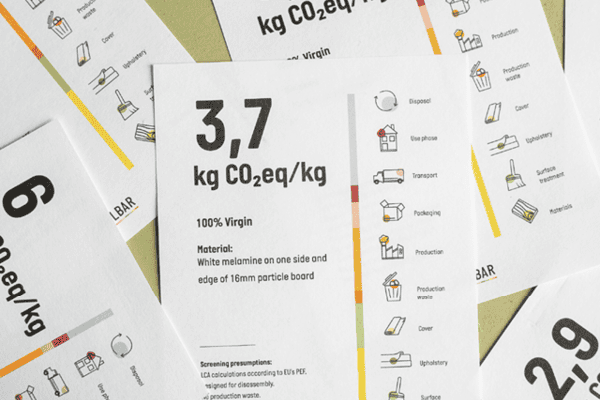
Two key methodologies are currently being used to assess the environmental impact of products:
- Product Environmental Footprint (PEF)
- Environmental Product Declaration (EPD)
While both serve the same overarching goal which is to evaluate a product’s environmental performance, they often produce different results. But why? And can we truly compare them?
We have obtained fresh research on this topic from our own PEF and EPD specialist. Her name is Claudia Anselmi, and she is one of our dedicated LCA consultants. She wrote her master thesis about these two LCA methodologies.
The origins of PEF and EPD
PEF is an initiative led by the European Commission, designed to harmonise Life Cycle Assessment (LCA) rules across EU member states. Claudia elaborates:
Having the same set of rules is one of the biggest strengths of PEF compared to EPD. Basically, there’s no room for interpretation in PEF. All assumptions have been defined, meaning that the same rules apply to everyone. If I have a PEF of a chair and a PEF of chair from another country, I can easily compare them. While with EPDs, the comparison is not straightforward even if it’s the exact same chair.”
This is because EPD does not follow a single regulatory body. Instead, it follows guidelines set by various so-called Programme Operators (POs). Because these base rules differ, direct comparisons between PEF and EPD and even between two EPD results can be challenging.
Product Category Rules (PCRs)
Both PEF and EPD rely on Product Category Rules (PCRs), which establish assessment guidelines for specific product types. However, there’s a key distinction:
- In EPDs, PCRs are developed by different POs, which means that the same product can have varying assessment criteria depending on which PO is used.
- In PEF, many PCRs—known as Product Environmental Footprint Category Rules (PEFCRs)—are still under development, adding uncertainty to comparisons between the two methods.
- The EU PEFCRs are always the same among the member states, while EPD PCRs can be different from country to country as they follow the Programme Operators.
“I feel there should be more collaboration between PEF and EPDs to develop more aligned PEFCRs. Then the methods would be more standardised” Claudia argues and continues: “PEF could also learn things from EPD and if they would collaborate and maybe adopt and adapt some of EPD’s category rules, PEF could both save time and incentivise for a smoother transition to PEF rules. And thereby increase comparability of LCAs overall.”
Differences in databases
PEF demands the use of ILCD-compliant datasets and recommends the EF (Environmental Footprint) 3.1 database. Meanwhile, EPD requires high-quality data but does not enforce the use of a specific database. This means:
- If two LCAs use different databases, their results may vary significantly due to differing system boundaries and inventories.
- EPDs do not always disclose the exact datasets used, making it difficult to replicate their assessments with another database.
Variations in methodology
Several modelling differences exist between PEF and EPD, including:
- Cut-off thresholds: PEF allows up to 3% of environmental impact to be excluded, whereas EPD International permits only 1%, meaning some processes might be accounted for differently.
- Allocation rules: Both methodologies rely on PCRs to determine allocation, but the specifics can differ based on product categories.
- End-of-Life (EoL) modelling: When a product is disposed of, we call it the ‘End-of-Life’ phase. We rarely know what happens to a specific product when the owner decides to get rid of it. So how can we calculate the impact from this stage?
-
- PEF uses average data and follows the Circular Footprint Formula (CFF), which takes a consequential approach to material and energy recovery. This means that it considers the interaction of systems and takes the wider consequences of recycling or recovering materials and energy into consideration leading to better distribution of credits and burdens.
- EPDs require realistic and current scenarios, but do not provide specific values to follow when modelling the end of life, which does not allow to have a fair split between credits and burdens coming from the different types of end-of-life of a product.
ILCD-compliant datasets refer to datasets that conform to the International Life Cycle Data System (ILCD) standards, which were developed by the European Commission to ensure consistency, transparency, and quality in life cycle assessment (LCA) data. These datasets must meet strict methodological requirements regarding system boundaries, data quality, and documentation.
System Boundaries define how many of the life cycles stages you include in an LCA.
Inventories are the processes of quantify requirements in terms of energy, material, waste, and emissions. Anything that enters or leaves the system of the product/process.
Allocation in this context refers to the way the method divides credits and burdens of for example the use of recycled materials. Who should get the credit; the company that uses recycled materials or the company that provides the recycled materials? Allocation rules answer these types of questions.
Comparing EPDs
Even within the world of EPDs, comparisons can be tricky. Different Programme Operators (POs) follow different guidelines. When Claudia Anselmi started her work, she was surprised.
It was interesting to learn that there are so many different programme operators (POs) in the world of EPDs resulting in many ways product EPDs can differ.”
For example:
- Life cycle phase divisions:
- EPD International divides processes into upstream core, and downstream phases.
- EPD Norway categorises them into production, use, and end-of-life phases—structured differently from EPD International.
- Data requirements:
- EPD International sets clear rules on the use of specific versus generic data.
- EPD Norway primarily emphasises data being up-to-date and modular (allowing integration with other subsystems).
Upstream phases refer to the stages before materials arrive at primary production. I.e. raw material extraction.
Downstream phases refer to the stages after the product leaves the factory, i.e. use phase.
The bottom line
PEF and EPD offer valuable insights into a product’s environmental footprint, but they operate under different principles, rules, and data requirements. Understanding these nuances is key to interpreting LCA results accurately and making informed decisions.
The Målbar approach
Målbar follows the EU PEF standard. And we asked Claudia to elaborate a bit more, on what she values within the PEF methodology.
The fact that a PEF LCA provides a single score reflecting the overall environmental performance on all 16 impact categories is a huge advantage. That number can be compared to the share of consumption footprint of an average person. This adds additional meaning, perspective, and understanding to the results. This is not possible with EPDs.”
Claudia also mentions the weighting system of PEF.
“The EU Commission has defined the relative importance of each impact category based on urgency and impact reach etc. Right now, climate change is the heaviest weighted impact category. But in the future, climate change might be less urgent and maybe ecotoxicity will become the most pressing environmental issue. It adds to the many ways you can use the results from PEF LCAs, and I believe it helps make it tangible and relatable to people.”
Is there any use for EPDs then?
Yes, I believe there is. EPDs also rely on robust data and are not random calculations. And they are still very popular and in high demand, especially in the construction sector, where I think they work well. Also, as long as PEF still develops their category rules (PEFCRs), EPDs should still be around. “

How do you see the future for these two methods?
“I think there should be much more collaboration between them. What worries me is that PEF is kind of behind on the product category rules, so if PEF would use EPD PCRs and then adapt them, PEF could come a long way faster.
I think EPD should continue being the standard in the construction industry because it works there and is created specifically for that industry. It’s where they belong. In addition, to improve more direct comparisons among products, harmonisation on rules for buildings among the different programme operators, would be beneficial. However, I believe PEF is the better option and possesses the most potential to be the standard on practically all other markets.”
In general, the LCA field develops quite fast. Changes are made all the time, so you really need to stay updated to ensure that your calculations stay valid. Staying updated on these developments is one of Målbar’s core tasks.
“It’s not like changes are made for fun. The fact is that we increase our knowledge and learn new truths rapidly. It’s a good thing.”
If this has caught your interest, you can read more about why we work with PEF here
And you can find more information on PEF here and on EPD here.


